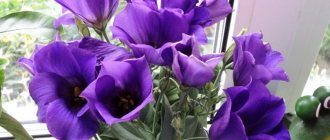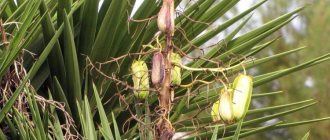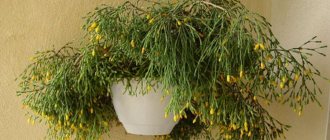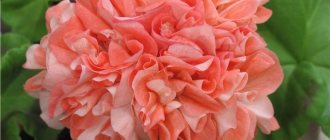- Description of eustoma
- Types and varieties of eustoma
- Russell's potted eustoma (Eustoma Russelianus)
- Garden eustoma grandiflorum (Eustoma Grandiflorum)
- Planting eustoma for seedlings
- Soil for growing eustoma
- Caring for eustoma seedlings and seedlings
- How to grow eustoma in peat tablets
- Prevention of diseases of eustoma seedlings
- Growing potted eustoma: care at home
- Watering and feeding eustoma
- Lighting and temperature conditions
- Eustoma flowering
- Eustoma after flowering: dormant period
Eustoma or Irish rose is a beautiful legendary flower native to North America. Despite its overseas roots, this culture has successfully taken root in our country.
Lisianthus is also grown by enterprising people, because a cut flower can stand in a vase for 18-20 days.
First of all, this plant is grown for cutting. Beautiful flowers, reminiscent of delicate silk half-opened roses, last a long time in bouquets. A wide palette of colors, the tenderness of the flower with amazing durability always surprises. Eustoma is grown as a garden, greenhouse, and indoor crop. And in any capacity, the plant will require very careful care, but even a novice gardener, having received the necessary knowledge about planting and care, will be able to enjoy a flowering plant in the garden or at home.
Description of eustoma
Known among flower growers also under the name of Russell's lisianthus, Irish, Japanese rose, Texas bell or love rose, eustoma is one of the most beautifully flowering crops. In both horticulture and floriculture, it is represented by only one species - grandiflora eustoma (eustoma grandiflorum).
Previously, three separate species were recognized in the genus Eustoma. However, joint work by employees of the Royal Botanic Gardens at Kew (UK) and the Missouri Botanical Garden (USA) to streamline the nomenclature of modern plant taxa, united the following species under a single name - Eustoma grandiflorum: Eustoma grandiflorum, Lisianthus - Eustoma Roussel's, or Russell's (Eustoma russellianum), Eustoma minor, Gentian minor, Western gentian, Blue marsh Eustoma (Eustoma exaltatum).
Wild form of eustoma.
Eustoma grandiflora is a luxurious plant from 30 to 90 cm in height with branched shoots, simple, elegant leaves with a bluish tint and flowers reminiscent of a hybrid of roses and poppies. Up to two dozen large luxurious flowers bloom on one plant per season, and due to the fact that they open not simultaneously, but alternately, eustoma remains attractive for an amazingly long time.
The ability of buds to bloom after the flowers wither is also preserved in bouquets: when buying eustoma or displaying it in vases, you can be sure that each bud will in turn turn into a beautiful Japanese rose. Each plant looks like a bouquet: due to its specific branching, strong, but slender, fan-shaped, eustoma really seems like a bouquet planted in a pot.
Eustoma, cultivar 'Borealis Blue' and yarrow cultivar 'Moonshine'.
Flowering of eustoma depends on the timing of sowing and begins 20 weeks after sowing. For classic garden eustomas, it starts in June-August and lasts until mid-autumn, because the plant will not stop delighting with flowers until the frost reaches -10 degrees and snow falls.
The color palette of eustoma today includes not only white, purple, pink, yellow, orange colors, but also various two-color and watercolor combinations. Compact indoor eustomas have colors that are usually clean and quite bright, while garden ones have a much wider range of colors. It even includes light green and fruity shades.
Variety of colors of eustoma.
The huge assortment of eustoma and its popularity all over the world are the merit of breeders in the USA and Japan. In the West, this plant is one of the most popular cut species, but here, too, this Japanese beauty is slowly gaining ground.
History of the appearance of eustoma
The origin of the unique flower eustoma or lisianthus, as it is more often called in Russia, dates back to the 19th century, when the Englishman Richard Salisbury classified and named the flower.
The fate of the plant changed radically only in 1933 after the selection of new plant varieties in Japan. And from that moment on, it spread throughout the world. It is especially popular in many states of America, Mexico, and New Zealand.
The meaning of the eustoma flower lies in its name; the name comes from the Greek word “Eu” which means “beautiful” and “Stoum” - “mouth”, “mouth”. Fully translated as “lovely mouth.” And lisianthus, this is the second name, sounds like a blossoming or bitter flower.
In addition to the official names, the plant has many names from the places where it is cultivated: Japanese, American, Irish, mountain rose, prairie queen, Texas bluebell.
Initially, it did not have such bright colors and diverse shapes. However, breeders have developed flowers of all shades of yellow, lilac, peach, double, with a border and with a combination of several shades.
Russell's potted eustoma (Eustoma Russelianus)
This flower has a small compact bush, its height rarely exceeds 30 centimeters. Let's get acquainted with the most popular varieties of potted eustoma:
Mermaid variety.
Lisianthus Little Bell.
The Mermaid variety has simple inflorescences up to 6 centimeters in diameter. The petals are pink-lilac or blue, the maximum height of the crop is 15 centimeters. The bush develops well and does not need pinching to form additional side shoots.
Lisianthus Light Bell is up to 15 centimeters tall with small simple inflorescences of different colors. The culture bushes well and does not require pinching of shoots.
Variety Fidelity.
Florida Pink variety.
Variety Fidelity is a beautiful flower with many white inflorescences. A feature of the culture is the spiral arrangement of peduncles.
The Florida Pink variety is a fairly compact bush up to 20 centimeters in height. The inflorescences are pink with simple petals that form a beautiful bouquet.
Rozzi variety.
Variety Sapphire.
The Rozzi variety is one of the tallest crops of the species in question, its height reaches 30 centimeters. Double inflorescences with white, blue or pink petals.
Variety Sapphire with simple or double petals. The inflorescences have different colors, the height of the bush reaches 30 centimeters.
Variety Echo.
Variety Aurora.
Garden eustoma grandiflorum (Eustoma Grandiflorum)
As the name suggests, this crop is grown as a garden plant. The flower is quite tall, similar in appearance to a rose, and is used for cutting and making bouquets.
Let us describe the popular varieties of large-flowered garden eustoma:
The Aurora variety of double lisianthus reaches 1.2 meters in height. Inflorescences of white, blue and pink shades. The peculiarity of the flower in question is the early formation of buds; it blooms two weeks earlier than the others.
Variety Echo with spreading thick stems up to 70 centimeters in height. It blooms early, forms large inflorescences, the petals have 11 different shades.
Heidi variety.
Variety Eustoma Flamenco.
Variety Heidi . A medium-height species with simple, numerous inflorescences, it comes in 15 different color combinations. The height of the bush does not exceed 90 centimeters.
Variety Eustoma Flamenco up to 1.2 meters in height. The culture has powerful, well-developed stems and simple but large inflorescences, their diameter reaches 8 centimeters. The main advantage of Flamenco is its low maintenance requirements.
Variety Variety Twinkie.
Variety Double White.
Variety Twinkie variety with simple inflorescences. Bushes up to 50 centimeters in height with pink, purple and yellow petals.
Variety Double White . A terry type with white inflorescences, a bush up to 70 centimeters in height, with powerful, erect shoots. It is low maintenance.
How do florists use lisianthus?
The eustoma flower is very popular in wedding bouquets and compositions because it remains fresh for a long time and retains its presentation, in addition, it adds special meaning to the bouquet.
In the language of flowers it means happiness and joy, so it is an excellent addition to any holiday and for a romantic wedding celebration.
Many people are interested: what is eustoma a symbol of? It is associated with purity and innocence, it is presented on dates, it is used to decorate wedding arches and, of course, it is used to make bridal bouquets. After all, every girl dreams of having an exclusive look on her wedding day. The Japanese rose will add sophistication, lightness and tenderness to the bouquet and decorations; it goes well with other flowers, so you can safely experiment with it.
Types of bouquets in which eustoma can be used:
- Ball-shaped, good for young, fragile girls. Their sophistication and tenderness are perfectly emphasized.
- Cascading, similar to a waterfall, are formed from lilies, roses, and the Texas bluebell acts as an addition and background.
- Bibermeyer is the most common and classic type of bouquets. This composition is always small, round or oval.
Mono-bouquets can also be formed from the prairie queen. They turn out so lush and airy, they look good as a classic option, but they will also be appropriate for fashionable, stylized celebrations.
A monochromatic bouquet represents love and celebration. It is tied with satin, lace ribbons or regular twine. Here it is important not to overdo it with decor and glitter.
It is possible to form a composition from fully opened buds and not yet opened ones
Planting eustoma for seedlings
The seeds of the crop in question are quite small; they are supplied to stores in the form of pills. You can collect your own seeds if you have these flowers on your site, but in this case the difference between the parent and subsequent forms will be more and more felt every year.
Collecting seeds for seedlings:
- In order for the seeds to ripen, it is necessary to remove some of the inflorescences and move the plant indoors at the end of autumn.
- When frost occurs, the plant pots should be taken to a warm place and trimmed, leaving two pairs of leaves.
- Provide a temperature of 8 - 10 degrees, reduce watering, stop fertilizing. The flower remains in this state until March.
- The plant is well pollinated by insects and produces seeds in special boxes. Collecting such seeds is not difficult.
- First and second generation hybrids tend to inherit the traits of the parent plants, so feel free to collect seeds from your lisianthus plants within two years.
- Third-generation hybrids will not inherit the characteristics of the original plants, but as an experiment, you can try to sow seeds collected from third-generation plants.
Irish rose seeds.
Note! Coated seeds do not require preliminary preparation, because their shell already contains a sufficient amount of microelements and other nutrients.
Soil for growing eustoma
We prepare the soil for sowing seedlings from equal parts of peat, garden soil and sifted sand. The end result should be soil with a neutral acid reaction. You can use Saintpaulia soil from store-bought mixtures.
Before moving to seedling containers, the soil is disinfected in a solution of potassium permanganate or placed in the oven for 30-40 minutes. There the earth is calcined at maximum temperature. The container for sowing can be special plastic boxes, disposable plastic cups or peat humus pots. Drainage from small pebbles is placed in the boxes and only after that the nutrient substrate is filled in.
Seed germination should occur in the light, so the grains are placed on slightly compacted and moistened soil, but not sprinkled with soil. To destroy the protective shell, the seeds are lightly sprayed with a spray bottle, then the containers are covered with a plastic bag or glass.
On a note! For better germination, seedlings are placed on a well-lit windowsill in a room with a temperature range of +20...+25 degrees.
Before emergence, the soil should be moistened with a spray bottle as needed. With the right approach, the first shoots will appear within two weeks from the date of sowing the seeds. Next, remove the cover and begin to care for the young plants.
Caring for the capricious Texas bluebell
It has rigid stems, and up to 30 flowers bloom in turn on each shoot. The cup is quite deep. The leaves are oblong with a bluish tint. The color is varied: shining white, all shades of pink, lilac, peach, burgundy, red flowers.
This overseas guest is a perennial under natural conditions, but gardeners care for it in the garden as an annual, and in a house, greenhouse or apartment they grow it as a perennial, it all depends on the gardener’s goals.
Many note that this American guest is quite finicky and difficult to care for.
Caring for eustoma seedlings and seedlings
Measures to care for hatched seedlings consist of maintaining optimal daytime temperatures at 20..25 degrees. The room temperature at night should not drop below +16 degrees.
Eustoma seedlings in cassettes.
Eustoma seedlings begin to be grown at the end of winter with short daylight hours, so the flowers should receive additional lighting with phytolamps. In general, crops should receive up to 16 hours of natural and artificial light per day. Water the seedlings using a pipette or a small syringe in a targeted manner. To avoid the occurrence of diseases, chemicals such as Previkur or Fitosporin are added to the irrigation liquid.
Note! At a certain stage of development, flower seedlings may be delayed in growth, but there is no need to worry. At this time, the root part of the crop is growing, while the above-ground part of the flower stands still.
After about 2 months from the moment of planting, the first pair of true leaves will appear on the plants, which means that the plants need to be transplanted into a larger container, for example, a disposable plastic cup. During picking, the seedlings are carefully removed from the soil using a toothpick or an awl. Make a hole in the new soil with your finger or pencil and transplant the seedling there.
After the diving process, approximately 10 days later, we add liquid fertilizers for flowers to the soil. We place the seedlings on a well-lit windowsill, which will prevent them from being stretched out due to lack of sunlight. When the seedlings grow a little, they are planted again into permanent pots with a diameter of 6-8 centimeters.
How to grow eustoma in peat tablets
Special peat-based tablets improve seed germination, and picking from such containers is much easier for plants. To grow Lisianthus seedlings, it is recommended to buy washers with a diameter of about 5 centimeters. They are placed several at a time in a food container and moistened with heated water.
When the tablets increase in volume, you need to drain the remaining liquid from the container and place one seed in the center of each of them. To speed up the destruction of the protective shell, the seeds are sprayed with water from a spray bottle. After this, the container is covered with film or glass and placed on a sunny windowsill. Seed germination occurs at a temperature of 20...25 degrees. After the formation of several true leaves, the flower seedlings are moved to a permanent pot.
Prevention of diseases of eustoma seedlings
Coconut substrate and plant fibers are prone to mold. Therefore, before using it, you need to treat it with potassium permanganate or a fungicide.
When germinating seeds, be sure to ventilate to avoid the appearance of mold:
- To prevent black leg and fusarium rot, Fundazol is used.
- Recently, many flower growers have fallen in love with epin and zircon. These drugs stimulate physiological processes in the plant body and increase stress resistance.
Picking seedlings
- When four normal leaves appear, the plant is ready for picking. Seedlings grown in a container or peat tablets need to be planted in separate pots; sometimes two or three plants are allowed in one container.
- This procedure will speed up the growth of the flower, make the plant stronger, and improve the development of the root system.
- Using a thin object, carefully lift the miniature plant and remove it from the peat soil.
- A small depression is made in the pot where the picking will be done. The sprout is transferred into this depression.
- The soil should be well moistened. Deepening is carried out along the lower leaves.
- Immediately after the procedure, put on a protective cap (plastic bag or plastic cup). The plants are kept in this state for several weeks.
- As a rule, plants tolerate picking well. In two weeks, your seedlings will already be twice as large.
Picking seedlings at the age of 2 months.
How to preserve eustoma in winter
“Before taking lisianthus from the garden, you should treat the bush with preventive agents to rid it of pathogenic spores and pest larvae”
We have already mentioned that eustoma in our area is grown as an annual, however, if desired, you can try to preserve adult bushes for the next season. To do this, you will have to dig them up and, transferring them to pots, take them home for the winter. Some gardeners initially use a trick, planting the plant directly in pots, then in the fall they get plants ready for wintering. All that remains is to remove the buried pots from the ground.
Eustoma in pots
The process of adaptation to indoor conditions, after living in the open ground, sometimes does not proceed smoothly. The period of acclimatization to new conditions may take up to a month. Plants have a hard time tolerating the change from outdoor coolness to home warmth and low light. They may weaken somewhat and even begin to wither. This is a reason to start moving the eustoma out of the garden early, around the end of August. At this time, the street and room temperatures are almost identical.
A short stay on a closed loggia can help the plant get used to the lack of light. In parallel with these actions, watering is limited. This measure is necessary, because during the adaptation period the bushes will not be able to absorb the same volumes of water.
In winter, light from the window will save eukoma from light deficiency
Sometimes you can find recommendations for pruning eustoma before planting in a pot, and it is recommended to do this almost to the root. After the procedure, the plant often throws out root shoots.
Before taking lisianthus from the garden, you should treat the bush with preventative agents to rid it of pathogenic spores and pest larvae. It should not cause disease in indoor plants.
Eustoma is a real decoration of the garden
No matter how well you take care of your eustoma, after five years you will still have to part with it, because with the change of generation it will begin to produce fewer and fewer flowers, and their sizes will become smaller and smaller. Sometimes the plant dies on its own, for no apparent reason. You need to approach this moment philosophically and not reproach yourself for the lack of attention to your beloved child.
Growing potted eustoma: care at home
In order for the Irish rose to develop well, it is necessary to create favorable conditions in the apartment. Let's get acquainted with some of the nuances of growing this plant.
An adult flower can grow to a significant size and will need to be moved to a new larger container. Eustoma does not like transplants, so the procedure must be carried out with special care. The plants are transferred from pot to pot, filled with new nutrient substrate and watered with warm water.
Caring for lisianthus in apartment conditions involves timely pruning and feeding of plants, maintaining the necessary air and soil humidity. Let's take a closer look at these procedures.
Growing lisianthus in natural and indoor conditions
Growing on site
The optimal time for planting is early July. Leave a distance of 10-15 cm between seedlings, choose a bright place, without exposure to direct sunlight. Around the same time, the first buds bloom and continue to bloom until frost.
To preserve it in winter, you need to dig it up, plant it in a pot and move it into the house. The only drawback is the lengthy adaptation to the new place, it lasts almost a month.
Growing at home
The best place for the Irish rose is light eastern and western windows; it is advisable to place the pot as close to the glass as possible to ensure a day-night temperature difference. After waiting for the end of flowering, the “Texas bluebell” is dug up and thrown away.
Although eustoma is a rare guest in our gardens and on windowsills in apartments, interest in it is growing every day. This flower from America remains fresh after cutting for up to three weeks and pleases the eye for a long time with beautiful half-open buds, shaped like a rose.
With careful care, the capricious lisianthus, one of the most beautifully flowering crops, will give you its beauty all year round.
We learn about the secrets of growing eustoma by watching the video:
Watering and feeding eustoma
In summer, the flower needs regular watering, but with the arrival of winter, their amount is reduced. During this period, each subsequent watering is carried out when the top layer of soil dries to a depth of 2-3 centimeters. To carry out the procedures, soft rain or settled tap liquid is used. The crop needs high air humidity. To do this, you can place a container of water next to the plant or spray the liquid near the flower.
Note! If water gets on the leaves and stems of plants, it can cause sunburn of plants, so water should be poured only at the root.
Fertilizers are applied to lisianthus every two weeks. For this purpose, special store-bought compositions for flowers are used in the dosage prescribed by the instructions. In winter, nutrients are not added to the soil. During this period, the plant should be at rest.
How to combine plants correctly in flower arrangements?
Magnificent bouquets are obtained from a tandem of roses and lisianthus. Plain colors will emphasize the tenderness and touching of the moment, and a combination of several shades looks impressive and original.
Together with freesia it brings lightness and airiness, looks good in photographs and looks non-standard. The bride's hair is decorated with freesia, and the plant stems are complemented with pearl beads and a beautiful ribbon.
The combination with alstroemeria is actively used by florists for fashionable stylish bridal bouquets. Plants complement each other perfectly and come in many color combinations, from pastel tones to the brightest colors.
Lisianthus looks great in pairs and complex compositions with callas, dahlias, chrysanthemums, gerberas and other large buds.
Lighting and temperature conditions
During development, the flower must receive sufficient heat and light. An adult plant will delight its owner with lush, long-lasting flowering for a long time if the pot is placed on a well-lit windowsill. Lisianthus prefers bright but diffused light. In this regard, the plant must be placed on the windowsills of eastern or southwestern windows. In case of persistent drought in the summer, the crop needs to be shaded.
When growing eustoma, it is necessary to create a special temperature regime. In summer, this plant feels good at standard room temperatures within +18...+25 degrees. In autumn, temperatures begin to gradually decrease. With the arrival of winter, the flower goes into a dormant state. During this period, it is recommended to take the culture out to the balcony or to another room where you can set the temperature to +10...+15 degrees.
Subtleties of breeding
Reproduction
Propagating a plant is not so easy. The problem is that this is not realized by dividing the bush. Adult individuals are not ready to recover from the destruction of the root system, which is an indispensable companion to the division process. The resulting divisions will also not be accepted. The cuttings also do not take root, so seeds remain the only available method of propagation for eustoma.
The optimal method of propagating eustoma is by seeds
They say that raising lisianthus seedlings from seeds is difficult, however, this is not entirely true. If you maintain optimal conditions for the seedlings in the first two months, then everything will go without incident.
When to sow?
Flower growers often sow seeds in December-January, but if you want to admire the aesthetic flowers longer, then this period should be expanded and the first batch of seeds should be placed in the ground in November. The final sowing month will be February. It makes no sense to sow eustoma later, in the spring. It simply does not have time to bloom, dying under the first snow. The secret is that the release of buds occurs at 15-20 weeks of growth, so consider whether the plant in your climate will have time to live a full cycle?
Nuances of the sowing process
It is recommended to sow seeds in disposable cups filled with a moistened soil mixture consisting of:
1. Peat soil.
2. Perlite.
3. Sand.
In this case, the soil will be looser and more breathable. If you don’t want to bother with preparing the soil, then you can purchase ready-made substrates designed for growing Saintpaulias.
Eustoma seedlings in disposable containers
Sow seeds superficially, without significant deepening. They just need to be lightly pressed into the soil. 3-5 seeds are placed in each container (calculated for picking). The seeded cups are covered with polyethylene to create a greenhouse effect and left alone until the seedlings germinate.
Just press the seeds a little into the soil
You can try another planting method, for which you will need peat tablets. Each of the tablets is soaked in water in turn. The seed is placed in the hole made, without further pressing down or sprinkling with earth. The “charged” tablet is sent into a disposable cup, which is covered with a lid. In order to ensure air access, the lid will have to be lifted periodically. With this method of germination, plants tolerate transplantation more easily and do not get sick, because root injury is completely prevented.
Planting eustoma seeds in a peat tablet
How to create comfortable conditions for seedlings
“In the first months of growth, eustoma needs bright but diffuse lighting, then the seedlings will germinate compactly and will not be too elongated”
In order for the seedlings to be strong enough, the seeds must initially be provided with good conditions for development. Lighting and temperature conditions will play an important role in this matter. In the first months of growth, eustoma needs bright but diffuse lighting, then the seedlings will germinate compactly and will not be too elongated. Fluorescent lamps can provide a similar light flow. By the end of winter, the seedlings can be moved to the sunniest windowsill. Under the rays of even a very weak sun, the seedlings will sharply increase in growth.
Eustoma seedlings need bright, diffused light
Ideally, you need to arrange a rack for growing eustoma seedlings, but if there is no space in the house for one, then you can get by with an ordinary shelf.
Racks for eustoma seedlings
The lower temperature limit of development for seeds is 20°, the maximum is 25°. Provided that the thermal regime is observed, the first shoots will appear on the 10-15th day. Do not be discouraged if in the first two to three months the growth of eustoma is practically unnoticeable. That's how it should be.
Seedling health
To prevent the seedlings from getting sick and to become strong, they can be watered with foundationazole in the first two months. The solution is prepared before use. A teaspoon of the substance is dissolved in a liter of water. To improve the development of plants, it is worth spraying them once with zircon or epin.
Zircon and epin for seedling growth
After this treatment, the seedlings actively begin to grow. In addition to the stimulating effect, the drugs have a protective effect and prevent the development of blackleg.
Picking process
If a month and a half has passed since the seedlings emerged, then it’s time to start picking. Planting into individual pots is a painstaking task and requires extreme caution. The jewelery of the work is the key to the rapid growth of lisianthus in the future. A thin awl will be a good assistant in extracting tiny bushes from the soil.
Picking eustoma seedlings
The hole in the new pot is made using a pencil. The seedling is inserted into the recess right up to the leaves. After replanting, lightly press the soil and also lightly moisten it. The process ends with the creation of a greenhouse effect. You can put a regular bag on the pot or cover the seedling with an inverted plastic cup.
Eustoma flowering
If all care rules are followed, the first inflorescences on the plant appear 5 months after the formation of the first shoots. During flowering, the gardener must constantly pick off faded buds, which not only spoil the appearance of the flower, but also provoke the development of certain diseases.
Note! If the crop care is correct and timely, then repeated flowering can be observed within three months after the first wave of ovary formation.











